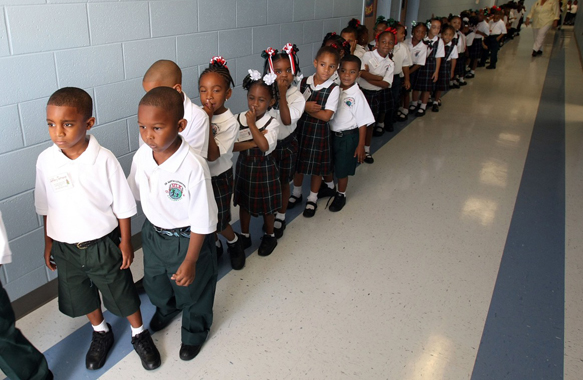For scores, overconfidence has proven to bring us down. What we characterize as confidence might more accurately be a reflection of the stories we tell ourselves. We exaggerate our expectations of consistency. We presume or believe that life is predictable. With little evidence for causality, we create a coherent story in our heads. Then, we trust the tale is true. Perhaps for boys the pronouncements are greater, as is the level of confidence and the false hope that that expectations are inevitability.
Los Angeles Times Opinion Bridging The Male Education Gap
To get more Americans working and set economic growth back on track, we need to understand what’s going on with men in education.
Despite rising college costs and the many other challenges facing America’s schools, women have made extraordinary strides in education. They have overtaken men in high school and college completion in the last few decades, earning 58% of bachelor’s degrees and 62% of postsecondary occupational certificates.
Our research has found that if men had the same educational distribution as women, their earnings would be 3.7% higher than they are and more men would be employed. Bridging the education gender gap is central to increasing America’s competitiveness in the world economy.
The educational shortfall of men has two important components. First, men are less likely to enroll in colleges and universities. Second, even when they do enroll, they are less likely to obtain a degree or certificate.
Why? One prime reason is young men’s poorer grades in middle and high school (despite performance similar to women’s on standardized tests).
A second factor is that young men are more likely than women to prioritize work over college when their short-term job opportunities are relatively good or their educational debt is relatively high.
The underinvestment in education by adolescent boys and young men stems in part from out-of-date masculine stereotypes. Such things as a strong attachment to school, a feeling of closeness to teachers, an excessive interest in high academic achievement or a fondness for art or music are viewed by many young men as unmasculine.
In a recent survey of American 15-year-olds, 73% of adolescent girls expected to work in managerial, professional or higher technical jobs, versus only 53% of the boys. Boys were much more likely than girls (9% as opposed to 2%) to expect to make their living as athletes or work in other sports jobs or as musicians. Too many boys expected to be military officers, police officers or firefighters relative to demand, and boys were more likely to respond vaguely or not at all to the question of the job they expected to have at age 30.
Overconfidence leads to unrealistic career expectations and poor planning. In the same survey, remarkably few boys expected to be working in the lower-level production or service occupations, even though nearly half of their fathers held such jobs. Unfortunately, boys’ rejection of “bad jobs” did not mean they had made plans to enter skilled occupations that require higher levels of schooling.
Relative to women, young men also have unrealistically high expectations of financial success. A pre-recession Gallup poll found that an astonishing 58% of 18- to 29-year-old young men thought it was “somewhat” or “very” likely that they would someday be rich.
For many boys and young men, the changing world is a conundrum. They want better jobs than their fathers have, but their attitudes toward school and work are misaligned with the opportunities and requirements in today’s labor market. Many boys seem to think they will be successful — career-wise and financially — without having any idea about how they’ll achieve that success.
This misalignment is made worse in the U.S. by a lack of clear links between academic courses of study and the skilled, well-paying jobs that actually exist in the labor market.
In Germany, the famous dual system of company and school training allows students to understand how their studies will translate into jobs. It provides 350 specific occupational certificates that provide entry into skilled occupations; about 40% of young German women and 52% of young German men complete training in one of these paths. Other young Germans complete full-time vocational school or get a university degree. The United States, with its high and disproportionately male college dropout rates, compares poorly to the German record.
It’s clear we need to encourage adolescent boys to adopt expectations in line with the job market, and to free themselves from anti-academic male stereotypes. If they can be helped to better understand the connection between doing well in school and getting a good job, they might see reasons to work harder in middle and high school. Clearer pathways from courses to credentials and from credentials to careers would further enhance the rates of success for men as well as women and make for a more competitive America.
Thomas A. DiPrete is a professor of sociology at Columbia University and former scholar at the Russell Sage Foundation. Claudia Buchmann is a professor of sociology at the Ohio State University. They are the authors of “The Rise of Women: The Growing Gender Gap in Education and What it Means for American Schools.”
Copyright © 2013, Los Angeles Times













Leave A Comment